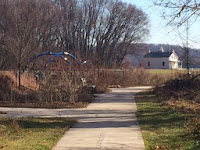 On my final run while I was in DC, I decided to stop and take some time to explore this weird area, and found out very quickly that it is a place called "Jones Point Park." A concrete marker just south of the lighthouse at Jones Point sets the very southern tip of the DC area, and some history explains that this occurred when Maryland ceded its land to create the District of Columbia. This photo shows the lines of demarcation between Virginia (right side of photo), D.C. (area in the center), and Maryland (left side of the photo).
On my final run while I was in DC, I decided to stop and take some time to explore this weird area, and found out very quickly that it is a place called "Jones Point Park." A concrete marker just south of the lighthouse at Jones Point sets the very southern tip of the DC area, and some history explains that this occurred when Maryland ceded its land to create the District of Columbia. This photo shows the lines of demarcation between Virginia (right side of photo), D.C. (area in the center), and Maryland (left side of the photo). Once again, this all seemed really arbitrary to me, until I read some more on the signs posted about the park--it appears that Jones Point was an original harbor used by ships that docked for shipments that were transported along Telegraph road in Virginia and that these shipments were largely composed from the tobacco trade of the time. If I learned anything in the upper division American history class I took during college called "The Coming of Civil War," it was that the economics of the tobacco trade were one of the most significant factors that divided the north from the south during this horrendous time of American history. We're all taught as children that slavery was the divisive issue among the states, but the reality is that slavery was brought into the south largely by the motivating factors of the southern plantations, and it was what made it seem okay for people who owned slaves to own them. It was what allowed one man to own another, and treat him like property instead of a person.
 So as I was standing there, taking a break from my run, I realized how petty all of this actually is--I was standing in a spot half in and half out of an area that recognized my marriage and thinking about how important that was, while in the not so distant past, it signified where and when it was acceptable for one man to beat and torture another, and use him until he was dead for something no more significant than the color of his skin.
So as I was standing there, taking a break from my run, I realized how petty all of this actually is--I was standing in a spot half in and half out of an area that recognized my marriage and thinking about how important that was, while in the not so distant past, it signified where and when it was acceptable for one man to beat and torture another, and use him until he was dead for something no more significant than the color of his skin.  I would like to think that our society has evolved past a point of racism, and past a point where little differences between people's heritages make a difference, but the reality is that we haven't. Black Americans have had full legal rights for many years now, but are still discriminated against on a daily basis. People are singled out on the basis of their ethnicity, their religion, their sexual orientation, and a huge list of differences that really don't matter because we are all people. It's time we got over this--we are bound to repeat the mistakes of our past, not because we didn't learn our history, but because we didn't understand what it meant.
I would like to think that our society has evolved past a point of racism, and past a point where little differences between people's heritages make a difference, but the reality is that we haven't. Black Americans have had full legal rights for many years now, but are still discriminated against on a daily basis. People are singled out on the basis of their ethnicity, their religion, their sexual orientation, and a huge list of differences that really don't matter because we are all people. It's time we got over this--we are bound to repeat the mistakes of our past, not because we didn't learn our history, but because we didn't understand what it meant.So I finished my run, and then I got home from my business trip a couple of days later and told my husband that I love him. I think that's the most important thing we can all do.






















